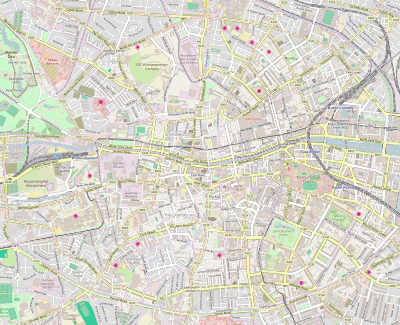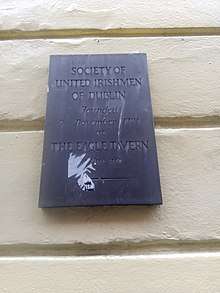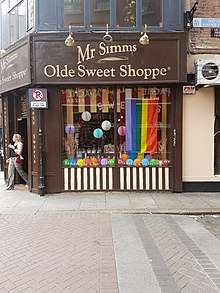Eustace Street
Eustace Street /ˈjuːstəs/ is a street in the Temple Bar area of Dublin, Ireland.
 | |
| Native name | Sráid an Iústásaigh (Irish) |
|---|---|
| Namesake | Sir Maurice Eustace |
| Length | 170 m (560 ft) |
| Width | 7 metres (23 ft) |
| Location | Dublin, Ireland |
| Postal code | D02 |
| Coordinates | 53.344975°N 6.264842°W |
| north end | Wellington Quay |
| south end | Dame Street |
| Construction | |
| Construction start | 1701 |
| Other | |
| Known for | Georgian architecture, Irish Film Institute, Quaker history |
Location
Eustace Street runs from Wellington Quay (near Millennium Bridge) to Dame Street, with junctions with Essex Street East and Curved Street.
History
Eustace Street takes its name from Sir Maurice Eustace (c. 1590 – 1665), former Lord Chancellor of Ireland, whose townhouse "Damask" and its gardens once stood on the site.[1] The street was laid out prior to 1701 but legal issues held up the initial construction. A map of 1728 shows the street as fully built.[2]
The street is known for its association with the Religious Society of Friends ("Quakers"). In 1692, the Quakers in Dublin established a meeting house on Sycamore Alley, off Dame Street and later expanded onto Eustace Street.[3] Eustace Street also once housed a Presbyterian/Unitarian church, which moved there from New Row in 1728; John Leland was a pastor there.[2]

In the 18th century, Eustace Street was the site of the Eagle Tavern, which was the site of the founding of the Dublin Society of United Irishmen.[4]
The street addresses were renumbered in the 1840s.[5]
In recent years the street has become a cultural centre, housing the Irish Film Institute and The Ark.[6][7] Fishamble: The New Play Company are located at 1 Eustace Street.[8]
Cultural references
Eustace Street appears twice in the work of James Joyce:
Darkness, accompanied by a thick fog, was gaining upon the dusk of February and the lamps in Eustace Street had been lit.
Watch! Watch! Silk flash rich stockings white. Watch!
A heavy tramcar honking its gong slewed between.
Lost it. Curse your noisy pugnose. Feels locked out of it. Paradise and the peri. Always happening like that. The very moment. Girl in Eustace street hallway Monday was it settling her garter. Her friend covering the display of. Esprit de corps. Well, what are you gaping at?
Irish band Delorentos released a single entitled "Eustace Street" in 2007.
Gallery
- Irish Film Institute (6 Eustace St);[11] sign visible for the Friends Meeting House (4–5 Eustace St) at left
- View facing north towards Temple Bar's main square
 Mr. Simm's Olde Sweet Shoppe, located on the corner of Eustace Street and Dame Street
Mr. Simm's Olde Sweet Shoppe, located on the corner of Eustace Street and Dame Street.jpg) View facing north
View facing north
See also
| Wikimedia Commons has media related to Eustace Street, Dublin. |
References
- "Dublin Street Names". December 20, 2007.
- Casey, Christine (February 17, 2005). "Dublin: The City Within the Grand and Royal Canals and the Circular Road with the Phoenix Park". Yale University Press – via Google Books.
- "The History of Quakers in Eustace Street". July 12, 2012.
- Murphy, Colin; O'Dea, Donal (February 24, 2014). "20 Things To Do In Dublin Before You Go For a Pint: A Guide to Dublin's Top Attractions". The O'Brien Press – via Google Books.
- http://www.irishtheatreinstitute.ie/attachments/424db5a1-af62-4790-8ab8-dc6c7aa1e004.PDF
- "Dublin's Temple Bar". homepage.eircom.net.
- Flynn, Roderick; Brereton, Patrick (July 30, 2007). "Historical Dictionary of Irish Cinema". Scarecrow Press – via Google Books.
- West, Michael; Kinevane, Pat; Dormer, Richard; Jenkinson, Rosemary; Riain, Ailis Ni; Lowe, Louise (January 29, 2015). "Contemporary Irish Plays: Freefall; Forgotten; Drum Belly; Planet Belfast; Desolate Heaven; The Boys of Foley Street". Bloomsbury Publishing – via Google Books.
- "Dubliners, by James Joyce". www.gutenberg.org.
- "Ulysses, by James Joyce". www.gutenberg.org.
- https://ifi.ie/visit/how-to-find-us/